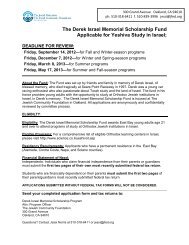East Bay Jewish Community Study - Jewish Federation of the ...
East Bay Jewish Community Study - Jewish Federation of the ...
East Bay Jewish Community Study - Jewish Federation of the ...
Create successful ePaper yourself
Turn your PDF publications into a flip-book with our unique Google optimized e-Paper software.
Involvement in <strong>the</strong> <strong>East</strong> <strong>Bay</strong> <strong>Jewish</strong><br />
<strong>Community</strong><br />
Formal and informal involvement in <strong>Jewish</strong> life is infrequent for most <strong>East</strong> <strong>Bay</strong> Jews, which is<br />
not surprising since <strong>the</strong>y are more likely to celebrate <strong>Jewish</strong> life at home with <strong>the</strong>ir family than in<br />
religious institutions. The most involved residents tend to be inmarried, have children, be more<br />
affluent and educated and live in <strong>the</strong> Western region <strong>of</strong> <strong>the</strong> <strong>East</strong> <strong>Bay</strong>.<br />
Specifically:<br />
• Few are formally involved in <strong>Jewish</strong> life; 15 percent describe <strong>the</strong>ir involvement in <strong>Jewish</strong><br />
life as a lot, while 66 percent say <strong>the</strong>y are involved only a little or not at all.<br />
• The most involved residents are married to a <strong>Jewish</strong> spouse (70 percent) and have a<br />
partner that always participates in <strong>Jewish</strong> life with <strong>the</strong>m (58 percent). Almost threequarters<br />
are providing <strong>the</strong>ir children with a formal <strong>Jewish</strong> education.<br />
• Synagogue and organizational membership are <strong>the</strong> most common forms <strong>of</strong> participation<br />
– 21 percent <strong>of</strong> <strong>East</strong> <strong>Bay</strong> Jews are dues paying members <strong>of</strong> a synagogue and 23<br />
percent belong to a <strong>Jewish</strong> organization 20 . Actual attendance, however, is low, with 9<br />
percent attending once a week or more; 67 percent say <strong>the</strong>y hardly ever or never attend<br />
religious services.<br />
• Involvement is driven, to some degree, by children. <strong>Jewish</strong> residents with bar or bat<br />
mitzvah-age children are particularly likely to belong to a synagogue and to be providing<br />
a formal <strong>Jewish</strong> education.<br />
• Synagogue membership is higher among better educated and more affluent <strong>Jewish</strong><br />
residents. Membership is also higher in <strong>the</strong> Western region <strong>of</strong> <strong>the</strong> <strong>East</strong> <strong>Bay</strong><br />
• A small number <strong>of</strong> <strong>Jewish</strong> residents – approximately 10 percent – volunteer, participate<br />
in informal ga<strong>the</strong>rings around spiritual life, and attend <strong>Jewish</strong> <strong>the</strong>med events monthly or<br />
more.<br />
• <strong>Jewish</strong> residents who are providing <strong>the</strong>ir children with a <strong>Jewish</strong> education are much<br />
more likely to report volunteering in <strong>the</strong> community; residents who attend events are also<br />
very likely to belong to a synagogue; and residents who attend spiritual events such as a<br />
Chavurah are more likely to identify with <strong>the</strong> Conservative and <strong>Jewish</strong> renewal<br />
movements.<br />
20 Synagogue membership is <strong>of</strong>ten over reported because it is a socially desirable behavior.<br />
37




